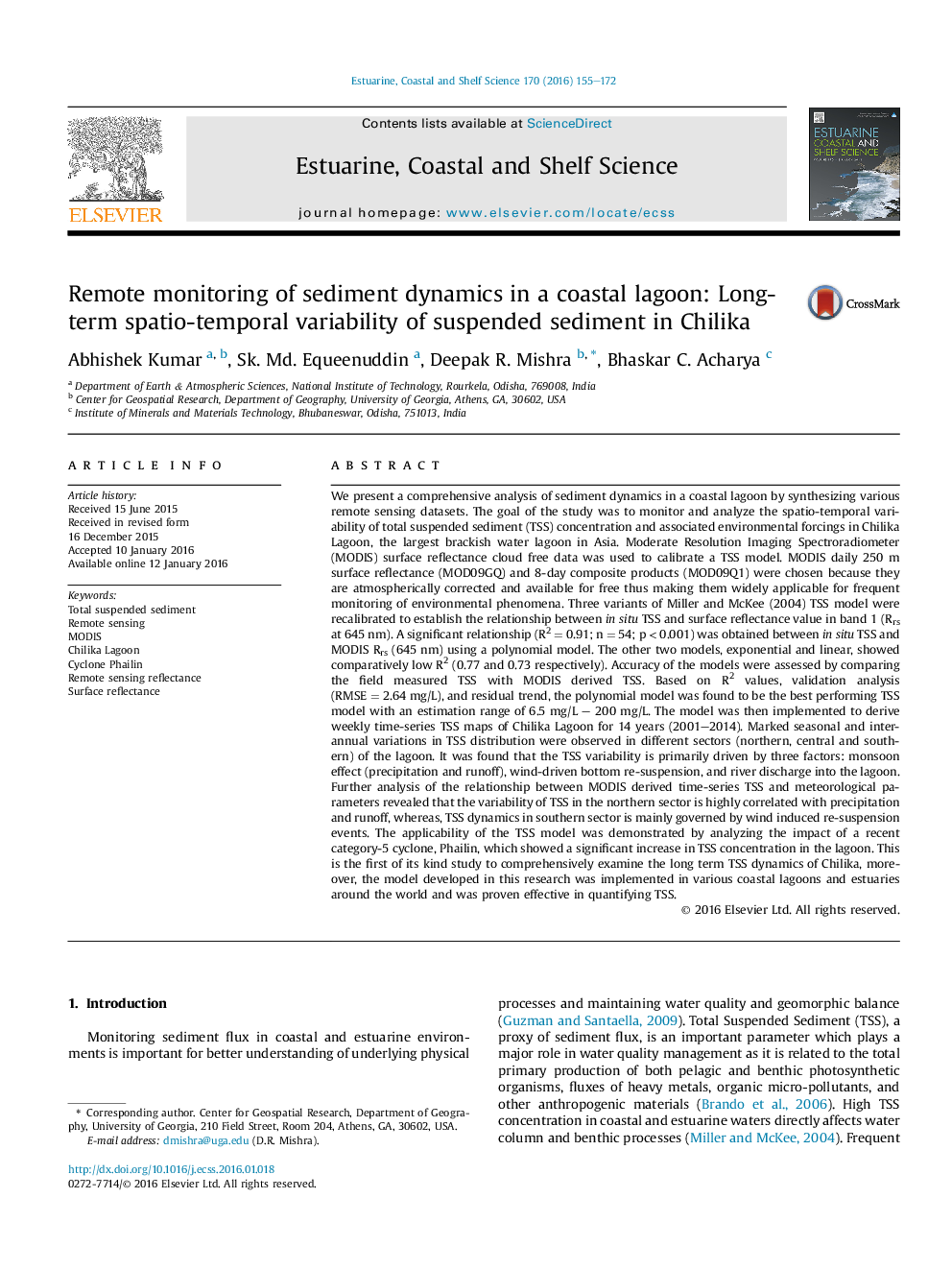| کد مقاله | کد نشریه | سال انتشار | مقاله انگلیسی | نسخه تمام متن |
|---|---|---|---|---|
| 4539258 | 1626629 | 2016 | 18 صفحه PDF | دانلود رایگان |

• We present a comprehensive analysis of sediment dynamics in Chilika, Asia's largest brackish water lagoon.
• MODIS 8-day reflectance products were used to reparametrize a robust TSS model in the range 6.5–200 mg/L.
• 14 years (2001–2014) of modeled TSS analysis showed the domination of seasonal variability over inter-annual variability.
• Wind speed was highly correlated with sediment re-suspension particularly in Summer months.
• TSS model was able to isolate the impact of the super cyclone Phailin on the lagoon's water quality.
We present a comprehensive analysis of sediment dynamics in a coastal lagoon by synthesizing various remote sensing datasets. The goal of the study was to monitor and analyze the spatio-temporal variability of total suspended sediment (TSS) concentration and associated environmental forcings in Chilika Lagoon, the largest brackish water lagoon in Asia. Moderate Resolution Imaging Spectroradiometer (MODIS) surface reflectance cloud free data was used to calibrate a TSS model. MODIS daily 250 m surface reflectance (MOD09GQ) and 8-day composite products (MOD09Q1) were chosen because they are atmospherically corrected and available for free thus making them widely applicable for frequent monitoring of environmental phenomena. Three variants of Miller and McKee (2004) TSS model were recalibrated to establish the relationship between in situ TSS and surface reflectance value in band 1 (Rrs at 645 nm). A significant relationship (R2 = 0.91; n = 54; p < 0.001) was obtained between in situ TSS and MODIS Rrs (645 nm) using a polynomial model. The other two models, exponential and linear, showed comparatively low R2 (0.77 and 0.73 respectively). Accuracy of the models were assessed by comparing the field measured TSS with MODIS derived TSS. Based on R2 values, validation analysis (RMSE = 2.64 mg/L), and residual trend, the polynomial model was found to be the best performing TSS model with an estimation range of 6.5 mg/L – 200 mg/L. The model was then implemented to derive weekly time-series TSS maps of Chilika Lagoon for 14 years (2001–2014). Marked seasonal and inter-annual variations in TSS distribution were observed in different sectors (northern, central and southern) of the lagoon. It was found that the TSS variability is primarily driven by three factors: monsoon effect (precipitation and runoff), wind-driven bottom re-suspension, and river discharge into the lagoon. Further analysis of the relationship between MODIS derived time-series TSS and meteorological parameters revealed that the variability of TSS in the northern sector is highly correlated with precipitation and runoff, whereas, TSS dynamics in southern sector is mainly governed by wind induced re-suspension events. The applicability of the TSS model was demonstrated by analyzing the impact of a recent category-5 cyclone, Phailin, which showed a significant increase in TSS concentration in the lagoon. This is the first of its kind study to comprehensively examine the long term TSS dynamics of Chilika, moreover, the model developed in this research was implemented in various coastal lagoons and estuaries around the world and was proven effective in quantifying TSS.
Journal: Estuarine, Coastal and Shelf Science - Volume 170, 5 March 2016, Pages 155–172